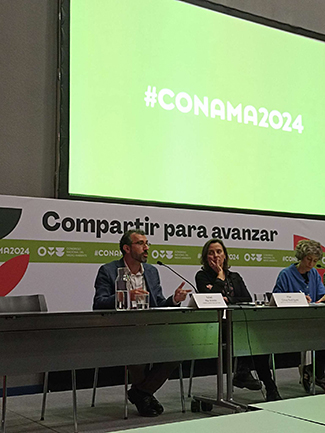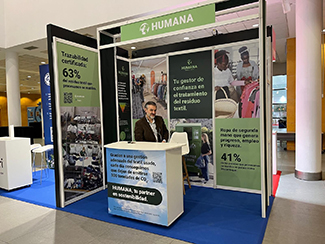consent_cookie
Duración: 1 year
Stores the user's cookie consent state
10-12-2024
The management of textile waste and resources was one of the main topics of analysis and debate at the CONAMA National Environmental Congress, held in Madrid from 2 to 5 December. Throughout the Congress, there were several events in which the present and imminent future of textile management was dissected.
One of the clearest conclusions, a fundamental pillar of Humana's speech, is that the sector continues to need greater professionalisation, transparency, traceability of waste and a global market that guarantees the sustainability of the activity itself, free from bad practices.
Rafael Mas, director of Projects and Institutional Relations at Humana, was one of the speakers at the round table 'Circular economy in the textile and footwear sector', held on 5 December, with the presence of a hundred people. Along with Mas, Pilar Chiva, Director of Circular Economy of the Waste Agency of Catalonia, Albert Alberich, Director of Moda Re, and Vicente Cambra, Deputy Director of R&D of the Textile and Cosmetics Industry Research Association AITEX, participated. Natalia Castellanos, Deputy Technical Director of the Spanish Association of Recyclers of Social and Solidarity Economy (AERESS), acted as moderator.
Textile waste vs. used textiles
During her speech, Mas made a precise analysis of the global market for used textiles, highlighting the fact that currently only between 10 and 12% of the textile waste generated each year in Spain is selectively collected. The rest ends up in landfill.
It is more than evident that the existing classification capacity in Spain is less than the selective collection that is carried out: Of the total textile collected, 85% ends up exported, either as waste - unprocessed used textile - or as a product - processed used textile.
If waste collection is to grow in the coming years, the capacity to process it effectively must also grow.
Exporting textile waste, the elephant in the room
Although there is legislation on the subject and regulations that allow or prevent the export of textile waste to certain third countries, there is also disparity in the interpretation of the Waste Transfer Regulations (1157/2024 and 1418/2007), where the responsibility for the transfer ultimately falls on the customs technicians of the different countries from which the maritime containers in which the textile waste is transported depart, transit or arrive.
In addition, it is soon possible that before exporting the waste it will have to undergo pre-treatment (presorting), which will make the process more expensive, putting the financial sustainability of the current management model at risk.
All of this is a clear risk for the sector, since it must be remembered that the new Waste Transfer Regulation will not come into force until May 2027, which will include clear criteria to support the sector in the optimal management of waste. At the same time, if textile waste is going to have less and less value because the quality of the garments continues to decrease, said waste should be able to be processed under conditions that allow costs to be adapted to this gradually lower value.
Exporting second-hand textile products, another key to the sustainability of the model
Exporting used clothing is a market necessity to achieve the maximum use of waste, now converted into a product. It is the only way to fully respect the waste hierarchy by taking advantage of a well-established value chain that allows access to second-hand clothing to a significant part of the world's population.
In the face of voices within the sector that constantly repeat that “the world market for used clothing is saturated”, here are some figures: Europe consumes 20-25 kg per inhabitant per year, Africa, 5 kg, and Mozambique, 1.3 kg. On the African continent, which has twice as many inhabitants as Europe, 80% of the population depends on second-hand clothing to cover their basic clothing needs.
The market is not saturated, you just have to do things right.
Positive impact of used clothing at a socio-economic level both in Europe and in the Global South
It is true that the export of this product has been questioned by external factors, related to bad practices and the consequent environmental alarm caused.
In a sector that works with margins of a few euro cents per kilo, bad practices should not have a place, but they exist, above all, due to a lack of control by the exporting countries.
These bad practices ruin the reputation of a sector that has coexisted in social, environmental and economic peace for decades. In a context of coherent practices, what is exported for reuse responds to the needs of the global market. It is not waste.
Used clothing also has a positive impact on the socioeconomic level both in Europe and on the African continent itself, as shown by a recent report by Oxford Economics.
A model that must prioritize the efficient and sustainable management of textile waste
During the debate with the other members of the panel, Rafael Mas made two issues clear: First, that more competitiveness is needed in the collection, transport and management of textile waste. Additional Provision 19 of Law 7/2022 restricts the market, and in practice does not put waste management in front of, but alongside or even behind labor inclusion, which does not help the sector.
Second, that it is necessary to encourage local reuse as much as possible, since it is the determining factor that allows the sector not to depend on aid, subsidies and grants. To achieve this, it is necessary to expand the network of secondhand fashion outlets, provided that they add value to the market and are financially sustainable.
The 3C urban agriculture program also had its space at CONAMA
On Tuesday, December 3, Paula Blázquez, Ecosystem Services Specialist at Humana, presented the 3C urban agriculture program Cultivating the Climate and the Community within the framework of CONAMA Innova, within the session of Technical Communications on Nature Restoration initiatives.
In addition, Humana had its own stand at the Congress, which was attended by numerous professionals interested in the sustainable management of used textiles.


